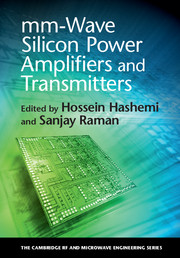Book contents
- Frontmatter
- Contents
- List of Contributors
- Preface
- 1 Introduction
- 2 Characteristics, performance, modeling, and reliability of SiGe HBT technologies for mm-wave power amplifiers
- 3 Characteristics, performance, modeling, and reliability of CMOS technologies for mm-wave power amplifiers
- 4 Linear-mode mm-wave silicon power amplifiers
- 5 Switch-mode mm-wave silicon power amplifiers
- 6 Stacked-transistor mm-wave power amplifiers
- 7 On-chip power-combining techniques for mm-wave silicon power amplifiers
- 8 Outphasing mm-wave silicon transmitters
- 9 Digital mm-wave silicon transmitters
- 10 System-on-a-chip mm-wave silicon transmitters
- 11 Self-healing for silicon-based mm-wave power amplifiers
- Index
Preface
Published online by Cambridge University Press: 05 April 2016
- Frontmatter
- Contents
- List of Contributors
- Preface
- 1 Introduction
- 2 Characteristics, performance, modeling, and reliability of SiGe HBT technologies for mm-wave power amplifiers
- 3 Characteristics, performance, modeling, and reliability of CMOS technologies for mm-wave power amplifiers
- 4 Linear-mode mm-wave silicon power amplifiers
- 5 Switch-mode mm-wave silicon power amplifiers
- 6 Stacked-transistor mm-wave power amplifiers
- 7 On-chip power-combining techniques for mm-wave silicon power amplifiers
- 8 Outphasing mm-wave silicon transmitters
- 9 Digital mm-wave silicon transmitters
- 10 System-on-a-chip mm-wave silicon transmitters
- 11 Self-healing for silicon-based mm-wave power amplifiers
- Index
Summary
Silicon has become the uncontested technology of choice for commercial radio-frequency integrated systems such as those in smartphones, tablets, and televisions. Research over the past decade has demonstrated the feasibility of realizing complex silicon integrated systems at millimeter frequencies. There is little doubt that operation at millimeter waves not only offers advantages, but also is necessary in many commercial and noncommercial applications. Millimeter-wave integrated circuits for automotive radars and high-speed wireless connectivity are already in the market. The fifth-generation wireless standards will include millimeter-wave operation as an essential component to increase the overall capacity. The volume of millimeter-wave integrated systems may soon exceed billions of units per year.
Millimeter-wave operation has a long history. Sir Jagadish Chandra Bose demonstrated transmission and reception of 60 GHz electromagnetic waves over a distance of 23m in 1895. The application of solid-state devices in the millimeter-wave range started in the second half of the twentieth century. In the 1970s, solid-state transceivers at 60 GHz were demonstrated primarily by using diodes for signal generation, frequency conversion, and amplification. Monolithic millimeter-wave receivers and transmitters were reported in the 1980s using III–V transistors capable of providing power gain well into the millimeter-wave region. Applicability of silicon technologies, including CMOS, for radio-frequency applications was established in the 1990s. Complex silicon integrated systems at millimeter waves were reported in the 2000s, and commercial products started entering the market shortly after.
Throughout history, technology has always been a limiting factor in the amount of radio-frequency signal power that can be generated. In the absence of devices that can provide power gain, generating electromagnetic signals will be power inefficient. Early demonstrations of electromagnetic signal generation at higher frequencies typically involve nonlinear processes such as harmonic signal generation. These approaches are gradually replaced with more linear amplification approaches once supporting technologies become available. In other words, efficient high-power electromagnetic signal generation and amplification oftentimes lags the demonstration and even deployment of wireless systems operating at those frequencies. It is hence natural to see that efficient high-power generation of millimeter-wave signals using silicon technologies is an ongoing research topic nearly a decade after the early demonstrations of complex silicon millimeter-wave integrated systems.
- Type
- Chapter
- Information
- mm-Wave Silicon Power Amplifiers and Transmitters , pp. xi - xiiPublisher: Cambridge University PressPrint publication year: 2016

